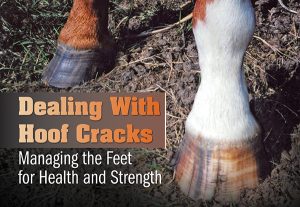Dealing With Hoof Cracks: Managing the Feet for Health and Strength
Click here to read the complete article
Pat Burton, a farrier in Texas, has developed effective ways to rehabilitate feet that suffer from cracking, using management rather than bar shoes or other types of special shoeing. “Every day, the hoof grows and changes. My philosophy is to try to encourage good hoof growth and try to minimize anything that would inhibit that growth or put pressure on the affected site,” he says.
“We’re trying to repair damaged tissue. We want to facilitate healing and regeneration; and, prevent fractures within the epidermal structures in the future. This is the premise of what I do—looking at the pattern of the hoof and the reason it all works together. There has to be a change in lifestyle for that horse, and full management. It’s not just management of the hoof (such as, trimming by the farrier) but also the nutrition, exercise, environment, etc. This is all part of what goes into correcting those feet,” he explains.
Burton has dealt with many severe and persistent cracks that have been present for years, in spite of attempts to heal them. “There is often a lot of dermal damage at the base of the tubules. There may be old scars that are difficult to get rid of. Even on feet that have actually grown out, some of them still have a line in the growth of the foot. There’s often a weaker area, but, in some instances, the scarring can create a stronger area. If everything comes back to proper order, and the horse develops a good foot again, the old scar is just a little thicker than the surrounding area. The dermal material now forms a stronger bond. If the hoof is going to crack again, it will crack on either side of the scar. It won’t crack on that old fracture line,” explains Burton.
CAUSES OF CRACKS
Click here to read the complete article











